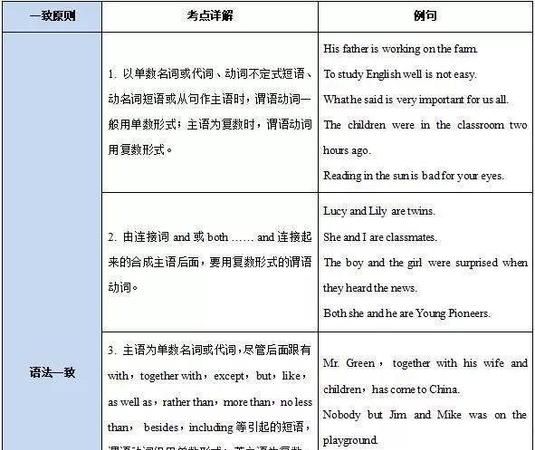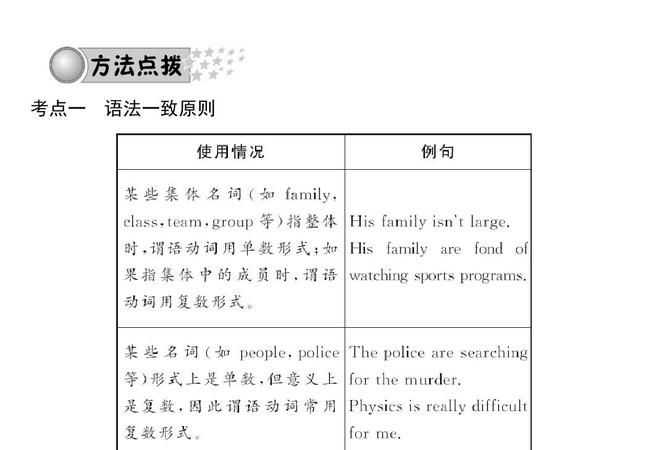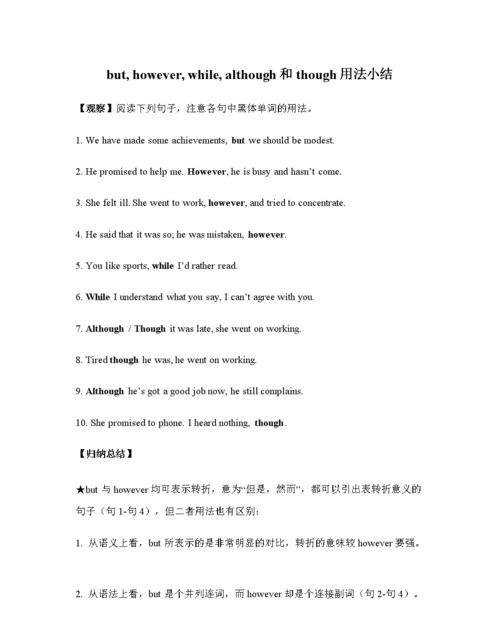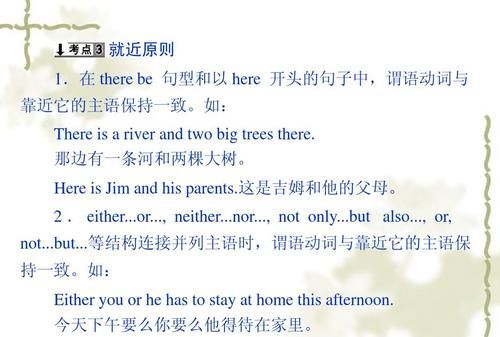本文目录
主谓一致形式一致
主谓一致的语法
一、最基本的"主谓一致"规则
初中课本中最基本的"主谓一致"规则是:"单则单,复则复",即主语为单数时,谓语动词也用相应的单数形式;主语为复数时,谓语动词也用相应的复数形式。例如:I am a teacher. We are teachers. 但要注意:当表示时间、长度、距离、金钱、度量等词组作主语时,常将其看作是一个整体,谓语动词要用单数形式。例如:Two years is quite a long time. Ten dollars is enough.另外,加减乘除也常当作整体对待,谓语动词也用单数形式。例如:Forty-one plus fifty-nine is one hundred. How much isninety-nine minus sixty-two?
二、集体名词作主语时,谓语动词的使用
family, class, team等集体名词作主语时,若指一个整体,谓语动词用单数形式;但若指其成员时,谓语动词用复数形式。例如:The family is very big. Their family arewatching TV now.
三、neither... nor..., either...or..., not...but...,not only... but also...等连词连接两个名词(或代词)作主语时,谓语动词要与靠近它的主语一致。例如:Neither he nor I know anything about it. Notonly the students but also the teacher has visited the museum. there be…结构也属于此类。例如:There is a teacher,a desk, a blackboard, some desks andsome chairs in the classroom.但要注意:both…and…表示"……和……都",谓语动词一般用复数形式。例如:Both his father and mother are doctors.
四、两个主语用and连接时,谓语动词的使用
and连接两个名词(或代词)作主语时,谓语动词一般用复数形式。例如:Mary and Helen are good friends.但要注意:and连接的两个名词只表示一个概念时,谓语动词要用单数形式。例如:A singer and dancer is coming.一个歌手兼舞蹈家就要来了。
五、politics, physics, works, the United States,news, maths等词作主语时,谓语动词的使用
这类形式上为复数,意义上却是单数的名词作主语时,谓语动词用单数形式。例如:The news is very exciting. Physics is a bitdifficult for me.但要注意有些名词,如:people(人;人们),police等则是形式为单数,意义是复数,谓语动词要用复数形式。例如:People there are very friendly
六、不定代词作主语时,谓语动词的使用
1.something, everything, anything, nothing,everybody, anybody, nobody, everyone, anyone等复合不定代词,以及either,neither(neither of), each (each of), each one, no one, another等代词作主语时,谓语动词用单数形式。例如:Neither of the answers is right. Somethingis wrong with my computer.
2. both, few, a few, many, several, others作主语,或它们所修饰的名词作主语时,谓语动词要用复数形式。例如:A few people can live to 100, but few canlive to 150. Both of them are in my class.
七、with, as well as, like等修饰的单数名词作主语,谓语动词的使用
单数名词作主语,且后面有with, as well as, like等修饰时,谓语动词用单数形式。例如:1.The teacher with his students has gone to the library. 2.Is the womanlike you your mother? 3.The instrument as well as other spare parts is going tobe airlifted soon. (该仪器以及其它一些备用件不久将空运。)
八、动词不定式(或动词不定式短语),V-ing形式以及名词性从句作主语,谓语动词的使用
动词不定式(或动词不定式短语),V-ing形式以及名词性从句作主语,谓语动词用单数形式。例如:1.To eat in a fast food restaurant is cheapand saves time. 2.Climbing hills is good exercise. 3.What interests the workersmost is better wages and workingconditions. (工人们最关注的是好的工资待遇和工作条件。

主语中有and时,谓语动词的单复数
常见用法 but一词在英语教材中复现率极高,用法也颇为复杂,现总结如下:一、conj. “但是”,“可是”,“而且”English may be hard,but it is the most important of all.英语虽然很难,但却是最重要的。注意:but 不能与although或though 连用,因为它们是连词,故不能同时出现在句子中,如:虽然他是个孩子,但是却懂得很多。Although he is only a child,but he knows a lot. (×)Although he is only a child,he knows a lot.(√)He is only a child,but he knows a lot.(√)二、adv. (=only) “仅仅” “只是”I can’t tell you but one thing—my age.我只有一件事不能告诉你,即我的年龄。You have but choices—follow me or refuse me.你只有两个选择,要么听我的,要么拒绝我。三、prep.“除了”(多和不定代词连用)1、 接人称代词They are all wrong but her/she.除了她以外,他们都错了。* 用she时,but为连词。2、 接介词短语You can put it anywhere but on the floor. 你就是不能把它放在地上。You can find that kind of thing nowhere but in England.这种东西只能在英国找到。3、 接形容词Shelooks anything but well.(She looks ill.) 她看来是病了。The park is all/anything but beautiful.这公园一点也不美。4、 接数词I know them all but two. 他们当中我只有两个不认识的。He lives in the next house but one.他住在隔壁的隔壁。She lives in last house in the street but two.她住在这条街的倒数第三家。* next but one/two 隔一/两个;第三/第四Last but one/two 倒数第二/第三5、 接不定式He wanted nothing but to stay here for another day.他只是想在这再呆一天。I have no choice but to tell you the truth. 我只有告诉你实话。There was nothing to do but (to) wait till help came. 只有等待救援了。* 如果谓语动词为实意动词do的某种形式时,but 后的不定式要省略符号to. 如:I can do nothing but let him know. 我只能通知她。They did nothing but complain. 他们只是抱怨。6、 接从句Nothing would contend him but (that) I must come. 必须我来了他才能满意。There’s no question but (that) he will succeed. 他一定会成功的。四、由but 构成的几个常用结构1、 but for “多亏…” “要不是” 多用于虚拟语气But for your help,I wouldn’t have succeed. 要是没有你的帮忙,我就不会成功。2、 not…but “不是…而是…”I meant not he but you should pay attention to pronunciation.我说不是他而是你要注意发音。3、 not only…but also “不但…而且…”Not only he but also I am interested in pop music. 不但他而且我也对流行歌曲感兴趣。* 该结构可以并列任何两个句子成分,在并列两个主语时,要注意谓语动词与就近的主语一致。4、cannot help but “不得不”,后接动词原形We cannot help but admit that the Chinese people are a great people.我们不得不承认,中华民族是一个伟大的民族.当然,but 的用法还有很多,这里就不再赘述.

主谓一致语法总结
主谓一致
主谓一致是指:
1) 语法形式上要一致,即单复数形式与谓语要一致。
2) 意义上要一致,即主语意义上的单复数要与谓语的单复数形式一致。
3) 就近原则,即谓语动词的单复形式取决于最靠近它的词语,
一般来说,不可数名词用动词单数,可数名词复数用动词复数。
There is much water in the thermos.
但当不可数名词前有表示数量的复数名词时,谓语动词用复数形式。
e.g. Ten thousand tons of coal were produced last year.
Large quantities of water are needed.
In western countries, mountains of rubbish are thrown away each day.
1 并列结构作主语时谓语用复数
Reading and writing are very important.
注意: 当主语由and连结时,如果它表示一个单一的概念,即指同一人或同一物时,谓语动词用单数,and 此时连接的两个词前只有一个冠词。
The iron and steel industry is very important to our life.
典型例题
The League secretary and monitor ___ asked to make a speech at the meeting.
A. is B. was C. are D. were
答案B. 注: 先从时态上考虑。这是过去发生的事情应用过去时,先排除A.,C.。本题易误选D,因为The League secretary and monitor 好像是两个人,但仔细辨别, monitor 前没有the,在英语中,当一人兼数职时只在第一个职务前加定冠词。后面的职务用and 相连。这样本题主语为一个人,所以应选B。
2 主谓一致中的靠近原则
1) 当there be 句型的主语是一系列事物时,谓语应与最邻近的主语保持一致。
There is a pen, a knife and several books on the desk..
There are twenty boy-students and twenty-three girl-students in the class.
2)当either… or… 与neither… nor, 连接两个主语时,谓语动词与最邻近的主语保持一致。 如果句子是由here, there引导,而主语又不止一个时,谓语通常也和最邻近的主语一致。
Either you or she is to go.
Here is a pen, a few envelopes and some paper for you.
3 谓语动词与前面的主语一致
当主语后面跟有with, together with, like, except, but, no less than, as well as 等词引起的短语时,谓语动词与前面的主语一致。
The teacher together with some students is visiting the factory.
He as well as I wants to go boating.
4 谓语需用单数
1) 代词each和由every, some, no, any等构成的复合代词作主语,或主语中含有each, every, 谓语需用单数。
Each of us has a tape-recorder.
There is something wrong with my watch.
2) 当主语是一本书或一条格言时,谓语动词常用单数。
The Arabian Night is a book known to lovers of English.
<<天方夜谭>>是英语爱好者熟悉的一本好书。
3) 表示金钱,时间,价格或度量衡的复合名词作主语 时,通常把这些名词看作一个整体,谓语一般用单数。(用复数也可,意思不变。)
Three weeks was allowed for making the necessary preparations.
Ten yuan is enough.
5 指代意义决定谓语的单复数
1) 在代词what, which, who, none, some, any, more, most, all等词的单复数由其指代的词的单复数决定。
All is right. (一切顺利。)
All are present. (所有人都到齐了。)
2) 集体名词作主语时,谓语的数要根据主语的意思来决定。如family, audience, crew, crowd, class, company, committee等词后用复数形式时,意为这个集体中的各个成员,用单数时表示该个集体。
His family isn't very large. 他家不是一个大家庭。
His family are music lovers. 他的家人都是音乐爱好者。
但集合名词people, police, cattle, poultry等在任何情况下都用复数形式。
Are there any police around?
3)有些名词,如variety, number, population, proportion, majority 等有时看作单数,有时看作复数。
A number of +名词复数+复数动词。
The number of +名词复数+单数动词。
A number of books have lent out.
The majority of the students like English.
6 与后接名词或代词保持一致
1) 用half of, part of, most of, a portion of 等词引起主语时,动词通常与of后面的名词,代词保持一致。
Most of his money is spent on books.
Most of the students are taking an active part in sports.
2) 在一些短语,如 many a 或 more than one 所修饰的词作主语时,谓语动词多用单数形式。但由more than… of 作主语时,动词应与其后的名词或代词保持一致。
Many a person has read the novel. 许多人都读过这本书。
More than 60 percent of the students are from the city.百分之六十多的学生都来自这个城市。

but在主谓一致中的用法
A BUT B 谓语跟A保持一致。 BUT=EXCEPT
ALL PEOPLE BUT TOM LIKE YOU=ALL PEOPLE LIKE YOU EXCEPT TOM.

以上就是关于but在主谓一致中的用法 ,主谓一致形式一致的全部内容,以及but在主谓一致中的用法 的相关内容,希望能够帮到您。

